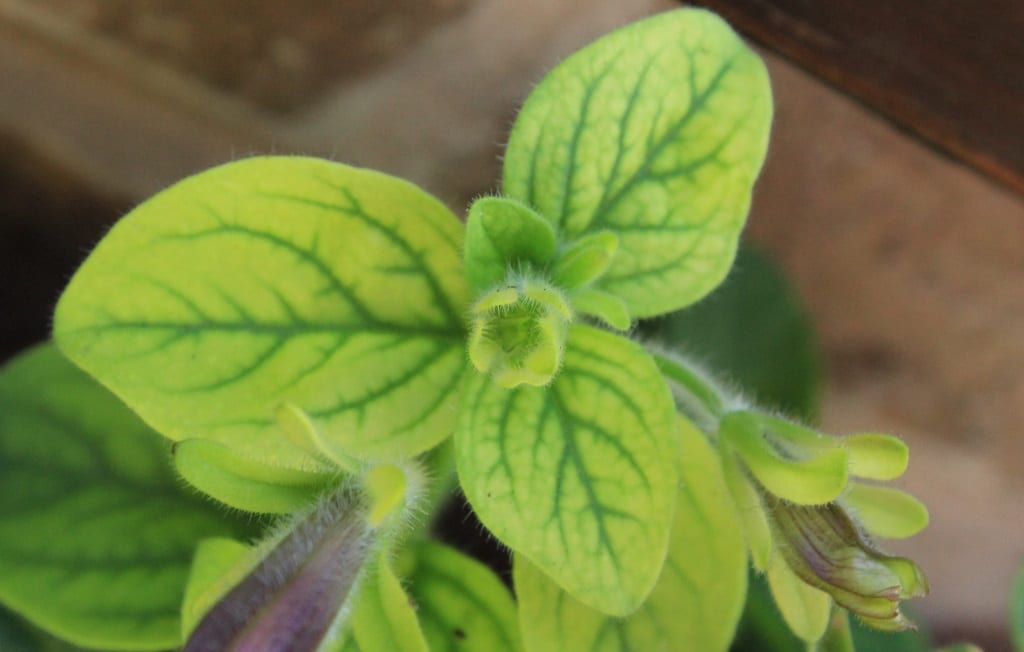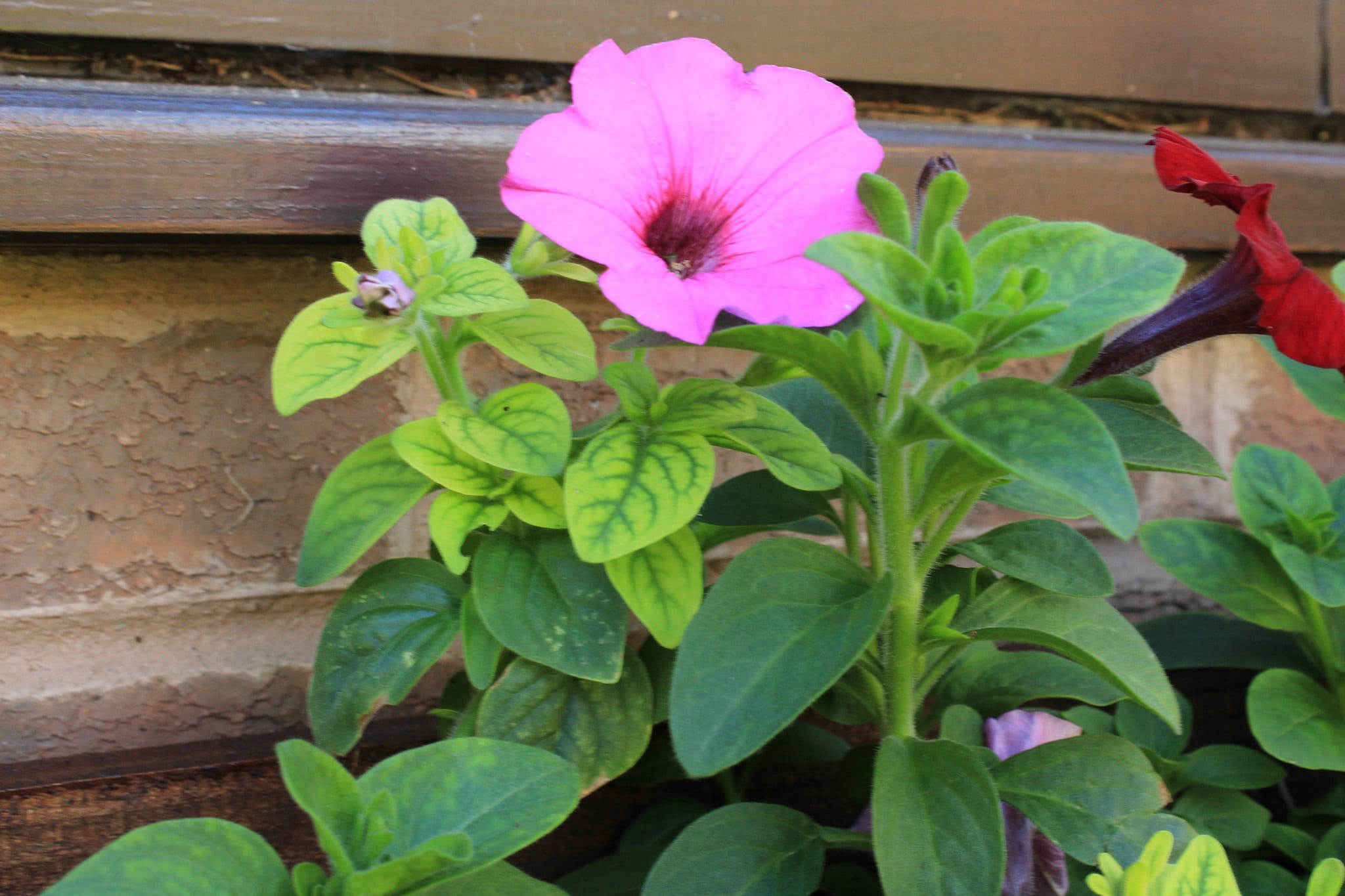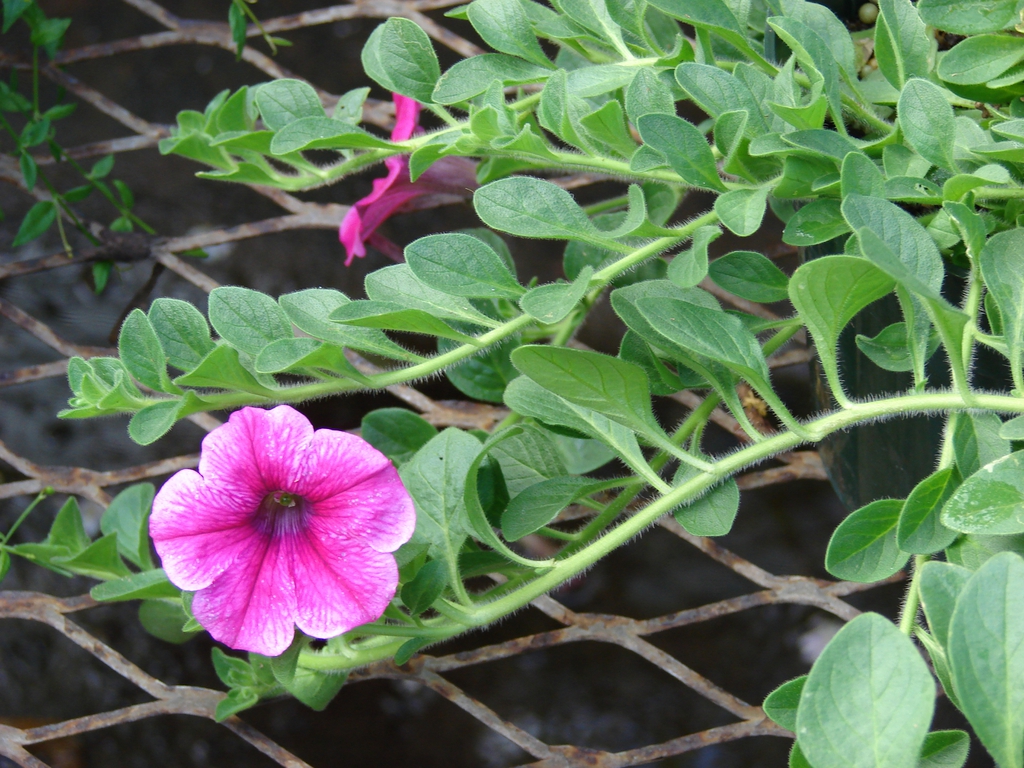
Petunias are delicate annual flowering plants that die back in the winter because they cannot withstand frost or freezing temperatures.
Petunias that are dying and drooping typically have fungal infections such root rot, which are brought on by an excessive amount of moisture surrounding the roots. Petunias require thorough watering once a week and cannot take soggy soil from over watering, which kills the plants by causing wilting of the leaves and blooms.
Yellow leaves are a sign of root rot, insufficient sunlight, or nutrient deficiency.
To avoid root rot or drought stress, it’s critical to strike the appropriate balance between watering and soil moisture in order to prevent petunias from dying.
Continue reading to find out the best ways to take care of petunias to keep them from dying and how to revive them so they can bloom again.
Table of Contents
Petunias Dying From Root Rot (Leaves Turning Yellow and Drooping)
The diseases root rot and botrytis, which are brought on by overwatering, poorly draining soils, and containers without drainage, are the most frequent causes of petunia deaths.
Petunias are indigenous to South America, where they flourish in direct sunlight, moist but well-draining soil, good airflow, and low humidity.
The conditions for fungal diseases like root rot and Botrytis are encouraged if the soil around the petunia’s roots is very wet or even bog-like. These diseases flourish in moist, slowly draining soils that remain saturated for an excessive amount of time after irrigation or rainfall.
Having too much water around the roots prevents oxygen from reaching the soil, which is necessary for root respiration even if the petunia does not develop root rot. The petunia’s leaves become yellow and wither if the roots are unable to breathe in the soil due to a lack of oxygen. This interferes with the roots’ capacity to carry nutrients and moisture throughout the plant.
When the soil is generously watered once a week, petunias grow because the ideal balance of soil moisture is maintained without generating the soggy circumstances that lead to root rot.
(Read my post on how to water petunias to find out how to determine the ideal petunia watering schedule for your climate and conditions.)
Petunias can endure some degree of dryness and, if established, can even withstand drought.
The weekly regimen of liberal watering and preventing the soil from getting too soggy imitates the regular watering cycle of the petunias’ natural habitat.
It’s significant to remember that excessive moisture around the roots of your petunias can occur for a variety of reasons in addition to overwatering, which results in yellowing leaves:
- containers and pots without base drainage holes. Some decorative pots lack drainage holes at the base or the holes get clogged with compacted soil, which makes it difficult for water to drain properly.
- Trays beneath, pots or containers. Due of the pots’ ideal drainage characteristics, petunias thrive there. However, if you put the pot on a tray to stop water from overflowing, this accumulates extra water after a rain or irrigation session and results in the soggy soil that promotes root rot.
- Petunias in hanging baskets are dying. Due to their resilience to drought-like circumstances, petunias are a favored flower for hanging baskets. A plastic sheeting or other impermeable substance may line some hanging baskets, which can assist them retain moisture but may also stop water from draining out the bottom. Boggy soil can result from this, turning petunia leaves yellow and giving them a droopy appearance.
- excessive irrigation. You are watering your petunias way too frequently if you are doing it every day. Reduce watering frequency to once per week, and only increase it during heat waves if the soil is drying out too quickly.
It can be challenging to save petunias that have been in soggy soil for a long time and are afflicted with a fungal illness.
However, if the excessive wetness is impeding root respiration, your petunia may just be exhibiting indications of stress. If this is the case, it can recover if you improve the drainage and water less frequently.
How to Revive Petunias With Yellow Leaves
- In order to increase drainage and avoid your petunias from turning yellow in a hanging basket, look to see if there is a plastic membrane and remove it if necessary.
- Make sure planted petunias are in containers with drainage holes on the bottom, and take out any compacted dirt there. In order to maintain proper drainage and avoid any obstructions to the drainage holes, you should ideally repot the petunias with fresh potting soil and add a 1-inch layer of gravel to the bottom of the pot.
- Your potted petunia should be elevated one inch from the ground by being placed on little feet or stands. Water may flow from the pot’s base if it is on the ground, but it may also get trapped underneath the pot and result in soggy soil conditions. By elevating the container, extra water may easily drain from the base and keep the soil from becoming saturated.
- To mimic the conditions of their natural environment, place your potted petunias in an open space with full sun and sufficient airflow.
- Always use multipurpose compost when planting petunias since it retains moisture (preventing wilting from thirst) and has a porous, free-draining structure that prevents the roots from sitting in muck.
- Always add a lot of compost to the planting area if your petunias are in garden borders to provide the ideal soil conditions for petunia growth. Put your petunias in pots if your soil is naturally soggy.
- Avoid planting petunias in clay soils because the clay retains too much moisture for the plants to handle and the soil’s structure is frequently too dense for the roots of the plants to properly grow.
- Reduce the frequency of your irrigation to once per week. Because of their South American heritage, petunias are resilient and reasonably drought tolerant. The reason your petunias are turning yellow if you water them every day is because you are overwatering them.
If you give your petunias the greatest care possible (full light, proper drainage, and weekly watering), the soil should have a chance to dry up and the plants should be able to bounce back.
It is crucial to stress that petunias that have spent a long period in saturated soil sometimes die back and cannot be revived.
Lack of Fertilizer can Cause Yellowing Petunia Leaves
Petunias don’t necessary require a lot of food, and they frequently flower more on medium-to-low fertile soils because too much nitrogen can inhibit flowering.
However, if your petunia variety is an especially vigorous grower and they are in a small pot (smaller pots have less capacity for soil and therefore less nutrients) or maybe in a garden border and competing for nutrients with nearby plants, they may need fertilizer to help green the leaves and stimulate growth.
Personally, I think petunias will grow best with a general, balanced liquid fertilizer like miracle-gro, which has all the nutrients at the right concentration.
Always adhere to the manufacturer’s instructions carefully and keep in mind that applying more fertilizer than is advised won’t improve your garden’s performance and may even slow down blossoming.
Your yellow petunia leaves should start to recuperate in the coming weeks with some fertilizer that is nicely balanced.
Petunias Wilting and Dying

Petunias, especially after planting, are susceptible to wilting and dieback caused by heat stress, hard compacted soils, and underwatering.
Petunias need a balanced amount of soil moisture, which is provided by planting them in multipurpose compost and providing them with a good bath once a week.
However, a few things can make your petunias more likely to wilt from drought stress:
- Petunias are planted in little shallow pots. Petunias can thrive even in confined spaces like pots, giving a show of mass blossoming. However, really shallow pots have less room for soil, which means they have less room for moisture and dry up more faster.
- consolidated soils. The budding root system of petunias may have trouble establishing itself and gaining access to moisture in heavy, compacted soils. Petunias need aerated compost that is porous so that the roots may expand and reach water farther down in the soil, which helps them withstand drought. If the roots are unable to spread out due to heavy dirt, they remain closer to the earth’s top, which dries out much more quickly and causes the petunias to wilt.
- use peat compost Petunias normally require watering once a week and prefer to grow in full light. The surface of the compost may dry out in the sun in between waterings. Compost that contains a lot of peat can bake hard and turn into something called hydrophobic material, which keeps water from sticking to its surface. Without effectively penetrating the soil and reaching the roots, water then flows off the top of the soil and down the side of the pot, hanging basket, or garden border. The petunias wilt and die back since there isn’t enough moisture available.
- In example, excessive air flow and intense heat can dry out hanging baskets. Petunias enjoy full light since it encourages flowering, but they can wilt in hot weather and windy circumstances because they dehydrate the soil and leaves. Petunias can withstand dryness and occasionally wilt to lower their leaf surface area and minimize water loss, before bouncing back in colder weather.
- Wilting is a result of transplant shock. After planting, the petunias’ root system may take some time to take root, making them susceptible to drought. Petunias may also briefly wilt as an indication of transplant shock due to the abrupt change in growing conditions when they are grown in a green house prior to purchase (or perhaps grown from seed yourself in a green house).
- Petunia wilting results from too little watering. Petunias should constantly be thoroughly watered even if they don’t normally need to be watered as frequently as other plants. Only the top layer of the soil is wet if you water too lightly. In order to get the water, this promotes the roots to grow close to the surface, making them more susceptible to drought.
How to Revive Wilting Petunias
- If you live in a hot area, plant your petunias in a pot that is at least 12 inches across and the same proportional depth. In cooler climates with heavier rainfall and more cloudy days, petunias may frequently be grown in considerably smaller pots. To avoid your petunias wilting, a larger container is better suited to hotter areas because it can hold more soil and retain more moisture.
- Before planting petunias, a lot of compost should be added to the soil. Compost’s more aerated texture and capacity to hold moisture make it easier for petunia roots to take hold after planting. The best thing to do if your petunias are in thick, compacted soil is to move them to pots and containers and transplant them in compost. In order to keep the petunia’s leaves and blooms from wilting and dying, this enables the roots to obtain moisture.
- Petunias shouldn’t be planted in compost that has any peat in it. When feasible, choose compost without peat because this type of compost is not only detrimental for the environment but also causes drought stress in petunias by deflecting water away from the surface when it dries out. Use garden compost to plant your petunias instead of commercial compost, which preserves a porous structure that allows water to permeate and reach the roots even when the surface is dry. Check the bag of any commercial compost to ensure that it is peat-free before purchasing.
- During heat waves, drink more water and make an effort to block strong gusts to avoid wilting. Petunias typically need watering once a week to maintain the ideal moisture balance and avoid wilting. However, to avoid wilting during heat waves, increase watering to once every two to three days. If it is very windy, transfer petunia pots to a more protected place and water them well so that they may recover from withering. Petunias prefer some air flow, but bear in mind that severe gusts can leech moisture for the leaves and cause wilting.
- Transplant shock after planting is reduced using appropriate potting soil or compost which holds moisture so that the roots can draw up water easier as they acclimate to the new soil conditions. After planting, water once every few days with a generous soak to encourage strong root development, making the petunia more drought-resistant and less likely to wilt as it gets older. If you place your petunias in the sun, they should recover from transplant shock and recover their wilted appearance with careful watering.
- Never give petunias a light watering; always give them a good soak. In order to guarantee that the moisture has reached the roots and to encourage proper root development, give the petunias a truly liberal soak, allowing water to flow from the base of the pots. This boosts the petunias’ resistance to hotter and drier circumstances and keeps the plant from withering.
When you create the ideal conditions with adequate moisture-retaining compost and thorough watering at least once per week to encourage deeper roots for more drought-resistant petunias, a dying petunia with wilting leaves should recover from drought within a week.
Petunias Dying in Cold Temperatures
Petunias are native to South America’s warmer environment, where they frequently wither away from sudden frost or a large temperature change (hardy in USDA zones 9-11)
Petunias are delicate as a result, and in milder areas they are frequently used as annual flowering plants for pots, hanging baskets, and garden boarders. Petunias wither away as the weather cools in the fall or winter, and occasionally wither away in the spring as a result of late spring frosts.
When there is a risk of frost where you live, grow petunias in pots or hanging baskets so you can take them into a heated greenhouse or garage until the danger has passed.
When petunias are grown in garden borders and cannot be easily brought indoors for protection from the winter, horticultural fleece can help keep them safe from cold nights and the occasional frost.
Petunias Require Full Sun
Your petunia needs more sun if it has poor, lanky growth, few flowers, and a withering appearance.
Petunias prefer at least 6 hours of sun to produce their best flowers and are accustomed to growing in wide spaces in warmer regions of South America.
Planting your petunias in the sunniest part of your garden will help to guarantee that they are as healthy as possible and produce blossoms.
By fostering a more favorable environment for your petunias to flourish, increased light exposure also lowers the chance of root rot and mold.
Move petunias that are grown in pots, containers, or hanging baskets to a location that receives direct sunlight to help them recover. Over the following few weeks, fresh, healthy growth and more flowers should start to appear.
Petunias Turning White

Always water your petunias in the morning so that any moisture has a chance to dry out in the sun before the cooler evening. This gives them moisture before the sunny day ahead.
When petunias are watered too late at night, they are forced to sit in wet, humid circumstances for an extended period of time, which promotes powdery mildew, which appears as white spots on the leaves.
Petunias are used to growing in open spaces with sufficient air circulation from sporadic breezes. They are more likely to turn white from powdery mildew if they are in a contained environment, especially one with high humidity.
If your petunia leaves are going white, refrain from using any fertilizer because powdery mildew usually affects lush green growth rather than established leaves.
Petunias are not often severely harmed by powdery mildew, and they frequently blossom with no noticeable damage. Learn more about treating powdery mildew by reading this article.
Petunias in full sun, with sufficient airflow, and watered prior to a hot day so that water on the leaves can evaporate, tend to cope with powdery mildew better than unhealthful plants that are not in ideal conditions for producing petunias.
Key Takeaways:
- Petunias that are dying are typically due to root rot, which is brought on by too much moisture around the roots from overwatering. To prevent dying from root rot, petunias should be grown in well-draining compost and watered once a week. Petunias wilt and turn yellow with a dying appearance on soggy soils.
- Petunia leaves can become yellow and die back due to overwatering, inadequate sunlight, and nutrient deficiency, among other factors. Petunias need at least 6 hours of sun per day to flower and keep their leaves from turning yellow. Because small pots have less soil and nutrients, petunias grown in them may turn yellow. To keep the leaves from becoming yellow, fertilize. Petunias should only be watered once a week, and you should make sure the soil is well-draining to avoid yellowing leaves from root rot.
- Drought stress can also cause petunias to wilt. Petunias frequently wilt in hotter areas if they are grown in shallow pots or hanging baskets because they can hold less soil and moisture, which leads the petunia to wilt as an indication of drought stress.
- Make sure that the soil is moist yet drains well if you want to save a dying petunia. Petunias are planted in well-draining compost, and this is accomplished by giving them a thorough soaking once a week. To assist petunias recover, place them in broad sunlight with sufficient airflow.
